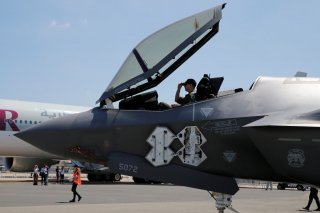China Has Big Plans for a New Stealth Fighter by 2035
But could Beijing's new plane really outclass the F-35?
China claims to be rapidly advancing artificial intelligence capabilities for a next-generation stealth fighter slated to emerge by 2035, according to a Chinese government-backed newspaper citing the chief designer of the J-20.
The description of technical plans and systems applications offered by the Global Times appears to mirror that which is often described about the F-35, meaning that it has an autonomous computerized ability to gather, organize and present an array of otherwise disparate pools of information for pilots.
Quoting J-20 designer Yang Wei, the paper states, “a future fighter jet will generally require a longer combat range, longer endurance, stronger stealth capability, a larger load of air-to-air and air-to-surface weapons, and the functionality to provide its pilot with easy-to-understand battlefield situation images and predictions.”
The emphasis of technologies engineered to provide pilots with “easy to understand” warzone intelligence aligns almost exactly with the often-discussed F-35 “sensor fusion.” In an F-35, data from 360-degree cameras, long-range electro-optical targeting, navigational details, threat warning systems and other variables such as speed, altitude and angle of approach, are all compiled, distilled, analyzed, integrated and presented to pilots on a single screen.
This kind of technical phenomenon is closely paralleled by the Chinese vision for its new generation fighter. For instance, the paper describes how, “in an integrated system, the aircraft should be able to form a network, draw real-time integrated situational images, create multiple attack routes, and transmit target information across mission areas in real time.”
At the same time, Artificial Intelligence (AI) is figuring prominently when it comes to early conceptual work and prototyping pertinent to U.S. sixth-generation stealth fighter work. Perhaps even more data, including electronic warfare, space, radar warning receivers, cyber and as-of-yet- unknown types of indicators will increasingly be incorporated into onboard AI systems. Advanced algorithms can quickly perform analytics upon a vast array of incoming information, bounce it off a seemingly limitless database and make near real-time decisions, computations and analyses. Improving the speed of decision-making and providing clarity for pilots are often referred to as “easing the cognitive burden.” These are the fundamental tenets of AI-empowered programs, therefore explaining the sought-after emphasis for a new generation of Chinese stealth fighters.
Referencing the famous, U.S.-created OODA Loop concept (observation, orientation, decision, action), the Chinese paper refers to its next-generation fighter as developing “OODA Loop 3.0.” The OODA Loop refers to how quickly a warfighter or unit can make a decision. The idea is you will lose the advantage and initiative if the enemy’s OODA Loop and decisions/reactions are faster than yours. Of course, China would love to have superior OODA Loop for its upcoming stealth fighter compared to America’s F-22 or F-35.
Conformal sensors woven into an aircraft fuselage, often called “smart skins,” are often thought of as examples of newer applications likely to inform sixth-generation fighter construction. Additional or new stealth configurations, advanced weapons such as lasers, adaptive engines and the “ability to command drones,” are all attributes cited in the Chinese report.
While much has been discussed regarding the stealthy exterior of China’s fifth-generation aircraft with respect to it appearing as a transparent or deliberate F-35 rip-off, less has been known about the internal technical specifics of advanced Chinese fighters. The true margin of difference, when it comes to what may or may not make a fifth or sixth generation aircraft superior to another, may likely reside in the area of AI and its impact upon computing, sensing, targeting, maneuvering and various kinds of attack tactics.
Kris Osborn is the new Defense Editor for the National Interest. Osborn previously served at the Pentagon as a Highly Qualified Expert with the Office of the Assistant Secretary of the Army—Acquisition, Logistics & Technology. Osborn has also worked as an anchor and on-air military specialist at national TV networks. He has appeared as a guest military expert on Fox News, MSNBC, The Military Channel, and The History Channel. He also has a Masters Degree in Comparative Literature from Columbia University. This article first appeared earlier this year.
Image: Reuters

